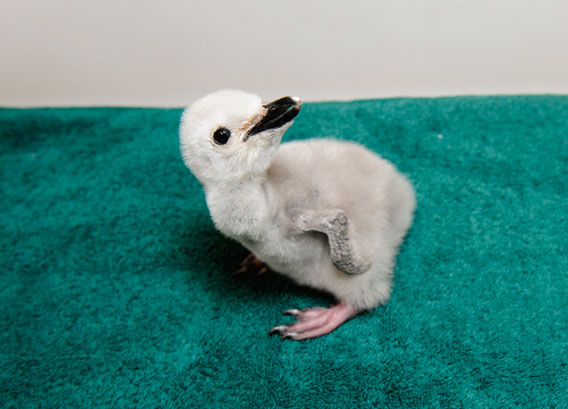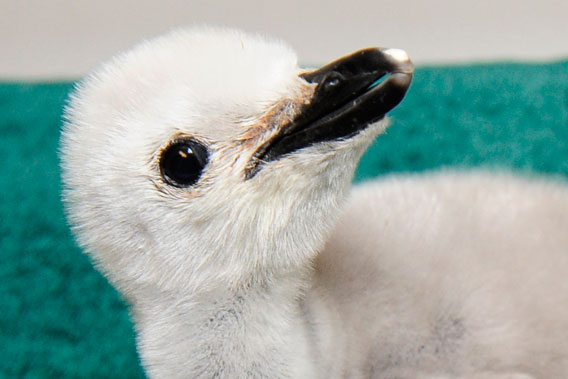
Chinstrap penguin chick. Photo by: Julie Larsen Maher.
A new blog, dubbed the Real Chicks of Central Park, is allowing visitors an intimate look at eight impossibly-cute penguin chicks. Including video, photos, and interviews the blog is an attempt to raise awareness about penguins. The highlighted chicks include four gentoo penguins (Pygoscelis papua) and four chinstrap penguins (Pygoscelis antarcticus).
“We wanted to show people what goes into hand rearing the penguin chicks from day one and share the growth process,” said Jeff Sailer, Director of City Zoos. “These new additions to the penguin colony are a success in animal husbandry and reflect the bird expertise we have at the Central Park Zoo.”
The chicks, which were born in the summer, are now on display at the zoo.
Chinstrap penguins are listed as Least Concern by the IUCN Red List, however a recent study found that populations may be in trouble due to a drastic decline in krill, which are having a harder time surviving in warmer Antarctic waters. Meanwhile, the gentoo penguin is listed as Near Threatened. It is imperiled by pollution and fisheries.
Penguins worldwide are facing a crisis: 60 percent of the world’s penguins are currently threatened with extinction. Penguin-expert Dr. David G. Ainley recently told mongabay.com that the biggest cause of global penguin declines is the competition with humans for food.
“The main threat [to penguins] is depletion of fish by industrial fishing […] Penguins need lots of food, nearby, reliably available. It’s easy for fishing to negatively alter this.”

Close-up chinstrap penguin chick. Photo by: Julie Larsen Maher.
Penguin Species According to the IUCN Red List
Endangered:
Erect crested penguin ( Eudyptes sclateri)
Galapagos penguin (Spheniscus mendiculus)
Northern rockhopper penguin (Eudyptes moseleyi)
Yellow-eyed penguin (Megadyptes antipodes)
Vulnerable:
African penguin ( Spheniscus demersus)
Fiordland penguin (Eudyptes pachyrynchus)
Humboldt penguin (Spheniscus humboldti)
Macaroni penguin (Eudyptes chrysolophus)
Royal penguin (Eudyptes schlegeli)
Snares penguin (Eudyptes robustus)
Southern rockhopper penguin (Eudyptes chrysocome)
Near Threatened:
Gentoo penguin ( Pygoscelis papua)
Magellanic penguin ( Spheniscus magellanicus)
Least Concern:
Adelie penguin ( Pygoscelis adeliae)
Chinstrip penguin ( Pygoscelis antarctica)
Emperor penguin ( Aptenodytes forsteri)
King penguin (Aptenodytes patagonicus)
Little penguin ( Eudyptula minor)
Related articles
The great penguin rescue: far-flung community cooperates, sacrifices to save 4,000 penguins from oil spill
(04/18/2011) One of the world remotest communities, the UK’s Tristan da Cunha archipelago, has come together to save 4,000 endangered penguins following a devastating oil spill, reports the Guardian. Last month a freighter ran aground on Nightingale Island releasing 1,500 tons of oil, potentially devastating the local population of northern rockhopper penguins (Eudyptes moseleyi), which are listed as Endangered by the IUCN Red List. However, fortunately for the penguins, the tiny community of 260 people living on the Tristan da Cunha archipelago were unwilling to give up on the oiled birds.
Antarctic penguins losing to climate change through 80% krill decline
(04/11/2011) Climate change has hit species of Antarctic penguins by causing a staggering decline in their prey: krill. A new study in the Proceedings of the National Academy of Sciences (PNAS) has found that both chinstrap penguins (Pygoscelis antarcticus) and Adélie penguins (Pygoscelis adeliae) have seen their populations decline likely do to less krill, instead of habitat changes. Since 1970 krill populations have fallen by 80% in the Southern Ocean surrounding Antarctica. Because krill require sea ice to reproduce, shrinking sea ice from climate change has made it more difficult for them to breed.
The penguin crisis: over 60 percent of the world’s penguins threatened with extinction

(06/10/2010) Everyone loves penguins. With their characteristic black-and-white ‘tuxedo’ markings, upright waddle, and childlike stature, penguins seem at once exotic and familiar: exotic because they live far from most human habitations, familiar because they appear in innumerable books and movies. From Mr. Popper’s Penguins to Happy Feet, and from March of the Penguins to And Tango Makes Three, penguins pop-up everywhere. The flightless birds have even provided the name and symbol to one of the world’s most successful publishing houses. Yet despite their popularity amid the human kingdom, few people seem aware that penguins worldwide are facing an extinction crisis.